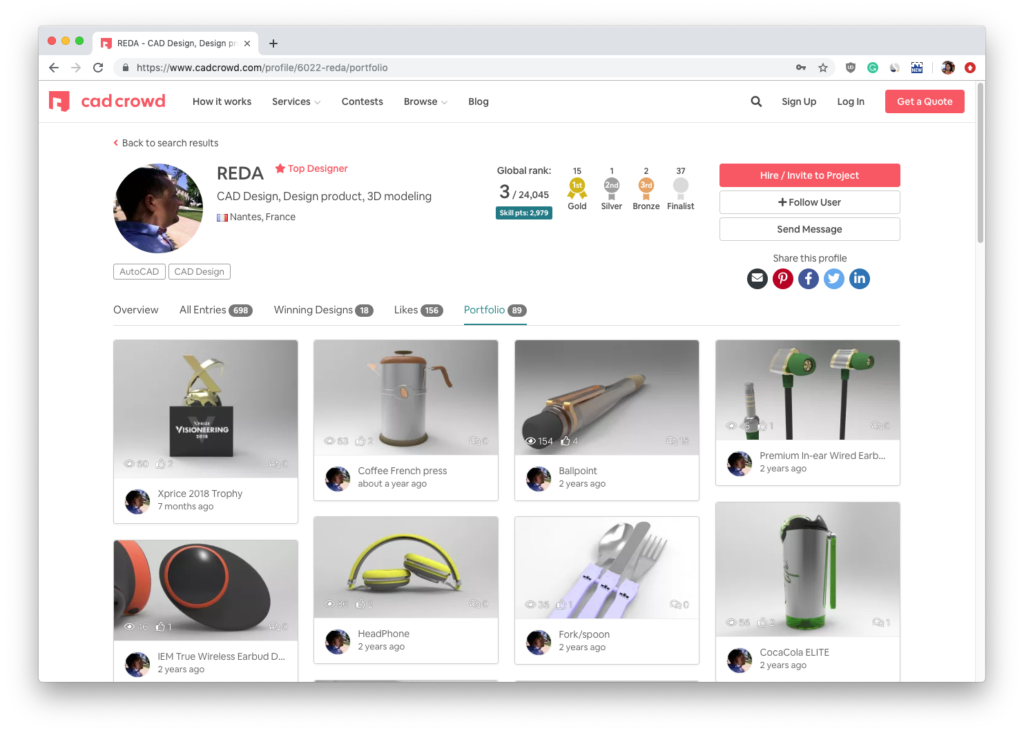3D rendering is an essential part of modern business. This process is used in many different industries, such as entertainment, gaming, TV, and architecture. For example, game developers may use 3D rendering services to create beautiful open worlds and detailed character models. Alternatively, architects could create stunning building designs using rendering software.
If you require 3D rendering services, you must use a third-party company or hire a 3D rendering freelancer. Knowing where to start this momentous task can be tricky. How do you know which companies are reputable? What should you look for in a 3D rendering business? How do you know they can provide the services you require? There are many different companies offering services such as this. Luckily, one way to find the best 3D rendering company is by looking at their portfolio or website.
In this article, we discuss 3D rendering portfolio websites. Additionally, we look at the information you can take from such sites to make an informed decision about your rendering requirements:
Step 1 – Understanding the Purpose of a Company’s Online Portfolio
First, you must understand the reasoning behind a company portfolio. This allows you to ascertain how useful the website is in your search for 3D rendering services. You may think, but surely I just check the portfolio, and if the work is quality, the company is suitable? This isn’t necessarily true. Understanding the purpose of the portfolio site helps give context and make your research more valuable:
Does the Portfolio Have a Specific Role?

Every website created has a role. A news website, for example, is supposed to deliver new and exciting news articles to the general public. Understanding the role of a portfolio website helps dissect the company and its offerings.
By definition, a portfolio website is used to showcase a person or a CAD services work. But that isn’t the only role. Portfolio websites could also have the following roles:
- To show the final polished work the rendering company produces
- To show the companies thought processes
- To demonstrate the company’s creative genius and vision
Look at the website. Which one of these do you think its purpose fulfills? It could be a combination of several different roles. By understanding the role, you can see how relevant the portfolio will be to your search for a rendering company.
What Is the Main Objective of the Portfolio?

Aside from a role, a portfolio site will also have an objective. Objectives and roles are different. A role is something that the website fulfills. An objective can be completed via the role a portfolio website has. Examples of objectives include:
- To document past, current, and future work
- To enable the business/person to find new clients
- To show abilities as a specialist (i.e., a rendering specialist)
If you understand both the role and objective, you can grasp just how useful a portfolio website could be. Moreover, this could dictate how much time you spend researching the company and its portfolio.
For example, let’s say a company has created a portfolio purely to keep a digital archive of its work. This portfolio would be useful to show their skill. But would it be helpful to provide information about their business, pricing, and processes?
Is It Current and Containing Up-To-Date Information?

Finally, a portfolio website should be current and relevant. When looking through a portfolio website, ensure the information is current. If you check out a website, only to find the last update was in 2010, how useful can it be?
A site with outdated information could contain old technology or even business processes the company no longer uses. In today’s modern world of 3D modeling, technology is changing fast. This is why it’s important to only look at portfolio websites that are up-to-date. Look for recent blog articles or recent projects the company has completed.
Step 2 – Finding Relevant Information for Your Business Needs
Once you have analyzed the portfolio website and its function, it’s important to look at the actual content. The website’s content is the most vital aspect of a portfolio site. This information is what you will use to make your decision—the complete project, the design, even the company history page. All different site aspects are essential so that you can build up a picture of what the 3D rendering company can offer:
Clues from the Website Design and Layout

The website itself provides important clues relating to the quality of a rendering company. Some rendering companies use a portfolio website as an extension of their creativity—they use it to show their skills, imagination, and of course, their rendering work.
Look at the website design. Does it contain any rendering? Is the website ergonomic and user-friendly? Has it been regularly updated and does it use the latest technologies?
When analyzing a website, you can gain a general idea of the quality of a 3D modeling service. If the website is basic with minimal graphics and outdated information, it could mean the business isn’t high quality. Alternatively, if the website is bursting with rendering examples and looks stunning, you can ascertain that the company takes great pride in its work.
As the saying goes, however, don’t judge a book by its cover. A rendering company may not consider their business website a priority—this doesn’t necessarily mean they are a sub-par organization. It could mean they simply prioritize their work, which is a good thing. Look at the website design and style to complement the other information you find.
Portfolio

The actual portfolio section is one of the most important parts of this type of website. The portfolio contains juicy information. This is where you can see exactly what type of work the rendering company can produce. It is important to look carefully at the portfolio section. Common features of a portfolio page can include:
- Past projects
- Current projects
- Details of software used and file formats
- Specifications of rendering
- Description of the design and creation process
- Client information
Portfolio sections can be extremely detailed or sparse. Some rendering companies will provide detailed past project breakdowns. These sections could include a host of useful information.
First and foremost, you can look at the quality of the rendering. This is hugely important! Can they make photorealistic renders? Would you want to use a rendering company that creates low-resolution renders with poor lighting and shadows? Of course not! Look at the rendering. Does it actually look good? Are the textures, lighting, and shadows realistic? What about the scale?
Secondly, look at the specifications and process of the rendering. What processes and software have been used? What were the customer’s original requirements? What input did the customer have? This information is important so you know what to expect from the service and process.
Thirdly, and finally, this is not a common practice, but you could consider contacting the clients. This requires a little more effort, but it can yield fantastic results. Speak to companies that the rendering business has worked for—find out what it was like working with them and the service they provided.
Price Plans

Pricing is obviously a vital aspect of finding a suitable rendering company. You want to choose a company that is cost-effective and has reasonable prices that reflects the quality of the service provided. Would it be a smart business move to pay over the odds for a service that turns out to be sub-par? Certainly not.
This is why when searching for the best 3D product rendering company, you should look at their pricing page (if there is one). Some companies will not provide generic pricing on their portfolio website—they may only operate a “prices available on request” policy. Don’t be alarmed by this—it is a standard practice within the industry. Remember that rendering can be a varied process—having a set pricing structure is sometimes not possible.
If a rendering company does have a pricing structure, be sure to take notes. Ask the following questions:
- What different price packages are available?
- What is included within these packages?
- Which package would be most suitable for your rendering needs?
In addition to the above, also compare prices to market rates and competitors. How does the pricing compare to other rendering companies? Does it seem reflective of the current market rates? By analyzing the portfolio pricing page, you can gauge how expensive a company is.
Services

A portfolio should have a services page. This is essentially what the 3D rendering company can provide for your business. The service page is one of the first website areas you should check. By using this page, you can quickly ascertain if the company can provide the services you require.
For example, let’s say you have a 3D rendering project for CAD designs. You look at the CAD service page – the services shown only include 3D rendering for architectural designs and building blueprints. To that end, you can conclude that the company can’t meet your requirements since architectural rendering services are different from what you need.
Ensure to analyze the services page carefully. It could contain a myriad of different information. Important pointers to look for include:
- Main types of services offered
- Software used to render 3D projects
- File formats supported
- End file format work is converted too
Understanding these points will give you greater insight into the services offered. You can then look at your own requirements and see if the business is suitable. It is also important to remember that a portfolio may not contain a detailed service page. If this is the case, it is advisable to telephone or email the company to inquire about their rendering services.
About Page or Company History

Most business websites have an “about” page or a “history” page. Usually, this is a basic content page that provides historical information about the company. It could contain information about how the business was formed.
Moreover, it could contain information about how the company has flourished since its inception and what it has to offer today. In addition to this, the about page frequently contains information about company policies, ethos, and even a mission statement. Finally, an about page could contain vital info about the personnel working for the company and details about their office location, etc.
All of this info is extremely important for your analysis and decision-making process. Firstly, understanding business ethos and mission helps you know what type of company it is, and what type of service you can expect.
Additionally, company history helps paint a picture of the business as an established entity. Would you want to use a 3D rendering company that was founded just a few months ago or a business that has decades of experience?
Finally, details of location and personnel can help provide an idea of who you will work with. It provides a personal element and helps you see the business as something more than just an online service. These are all important factors that can help choose a high-quality 3D rendering company.
Blog

In modern web design, most companies now maintain a regular blog. Blogging has never been as popular. A blog can provide additional insight into a business and its operations. Moreover, it can show different processes and promote new products or services. Businesses use blogs as an additional means of promotion.
Furthermore, they use them to drive traffic to their website and help provide social media content. Generally, if a 3D rendering company has a blog, you can deduce that they understand modern marketing, and also take pride in their business.
Look for a dedicated blog page. Check the articles—how recent is the last post? What particular types of blog articles are there? Are they mainly marketing pieces aimed at boosting traffic? Or maybe they show that the business owners care and take pride in their work. A blog can provide a unique insight into the quality, ethics, and work rate of a 3D rendering company. Moreover, it can often provide a source of information on recent projects and customers the business has worked with.
Cad Crowd Has a Network of 3D Rendering Professionals
Selecting a suitable 3D rendering company doesn’t have to be stressful. If you make use of a company’s portfolio website, you can gain a greater understanding of what they have to offer.
Moreover, you can use the website as a point of reference when comparing a business to its competitors. Failing this, don’t forget that Cad Crowd can provide assistance searching for a suitable rendering company! Find out how it works.
